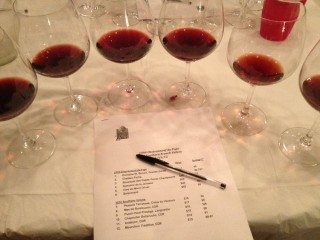Early critical accounts pegged the 1998 Chateauneuf du Pape vintage as monumental. Grenache and Syrah flourished under favorable growing conditions. Yet, decade old tasting memories bulged from powerful, tight, and stubborn bottles expressing convincing cellar potential. Could a dozen year term of lingering dark, cool rest unveil beauty beneath youthful armor? With this in mind, our Boston blind tasting group kicked off another annual tasting series with a flight of these 1998 southern Rhone wines.
Our second flight was filled with 2010 southern French values including Cotes du Rhone, Cotes du Ventoux, and Languedoc wines. It seemed like a good idea in planning, but following up on the older Chateauneuf du Papes with these brash younger wines proved incongruous. Regardless, there was discovery and learning about a wine’s ability to express place. But, more on that and the 2010 French values next week.
Tasting only six Chateauneuf du Papes produced by separate producers from the same vintage admittedly lacks comprehensiveness. Nevertheless, style diversity was in evidence as were threads to showcase the wines’ common heritage. Here are the wines (and their original release prices) selected for this examination:
- Bousquet des Papes Cuvee Chantemerle $45
- Domaine St. Benoit Grande Garde $42
- Domaine de la Janasse $60
- Clos du Mont Olivet $40
- Boisrenard $50
- Fortia $30
The best examples show off intoxicating perfumes of sweet, rich black cherry. They grudgingly hang on to strict tannins and concentrated fruit. The weaker wines are starting to lose some balance and depth of fruit, with missing richness and verve on the mid palate. They weren’t bad, just not as good side by side. Practically all the bottles would pair well with some dish and delight fans of this style of wine in any restaurant. One bottle, the Domaine St. Benoit, was oxidized and completely undrinkable despite a clean cork and seal. While these examples demonstrated unevenness in age-ability, there was something worth appreciating in all the wines, except the St. Benoit.
Here are the wines in the order of group preference, all tasted blind, followed by my personal assessment:
Boisrenard ****1/2- Along with our group, I prefer this wine above all others. It stands alone in terms of concentration. Intense black/purple color, the perfume is sweetest of all with berries, kirsch, camphor, smoke, meat, and anise all combining on the nose. A totally exotic wine with softening round fruit and stiff tannins, it has years and years to go. There is no mistaking that this wine has evolved the least of all and feels more youthful than most. No matter, it shows a confluence of flavors and aromas that are evolving at a snail’s pace.
Bousquet des Papes Cuvee Chantemerle *** – The group’s second favorite wine produced the regional garrigue character that was conspicuously missing from the other wines. For that reason along with some earthiness and interesting black cherry fruit , the wine won points from me before losing favor from thinning fruit and less expressive aromatics.
Domaine de la Janasse **** – Coming in third with the group, this was my second favorite wine. Dark purple and almost approaching the concentration level demonstrated by the Boisrenard, it shows some green and minty character. Stewed berries combined with coffee aromas and finished with a slightly perceptible raisin character. Despite the advanced nature of this Janasse, the wine is still very, very fresh, and has lasting tannins that will carry it much further down the line. It is a thrilling wine that is more favorably impacted by its age compared to the others.
Fortia $30 **1/2- Robert Parker rated this wine in the low ninety point range on release, and then lowered his opinion to 75 points retasting it a couple years ago from magnum. Parker rates wines 75 points? Chateauneuf du Pape? Maybe he had a bad bottle. For some folks like Richard Auffrey from the Passionate Foodie, it was their favorite wine. I can see how Parker would be disappointed though. It does not pack anything resembling walloping rich fruit. Red brick in color, menthol and sweet/medicinal cough drop aromas preceded a nicely balanced and more elegant styled wine. A touch of bitterness made me less enthusiastic about it than some, but nothing provided any insight into what Parker was tasting for him to reach such a low opinion.
Clos du Mont Olivet ***1/2 – The group voted this as the least favorite aside from the fully oxidized St. Benoit. I give it more props than that. From my point of view, the wine is riveting. Dark in color, lovely earthiness, smoke, licorice, and bright raspberry sweetness flows from the glass. The mouthfeel is more gorgeously supple and round than any other in this flight. This bottle is alive and full of perkiness and it has managed to age with preserved balance and increased harmony.
Domaine St. Benoit Grande Garde – Oxidized.
The flight left a few of us wanting more, mainly because the styles of these wines were so distinctly different but obviously related. We wanted more producers showing off their land and style renditions to see how a wider range of 1998 Chateauneuf du Papes progressed in bottles and cellars over time. The evolutions from restrained youth to expressive mature wines with myriad nuance was remarkable. We wanted more, more, and more. Instead of more, we moved on to younger versions of French Grenache and Mourvedre from places other than Chateauneuf du Pape, which you can read about next week.
